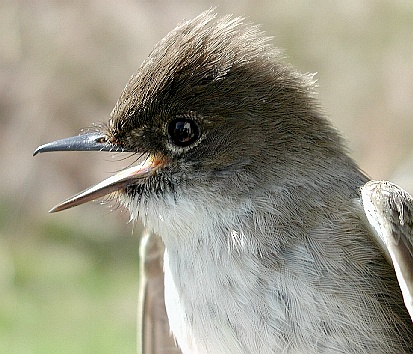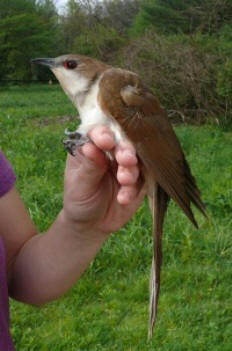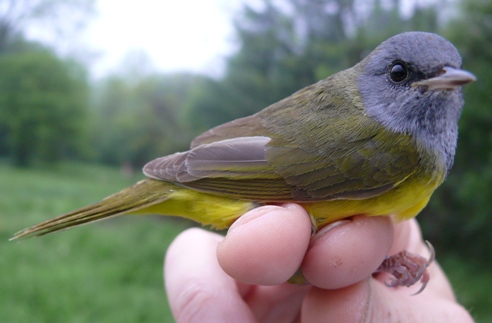Spring 2012
Spring is always a season of change at the banding lab. As we await the return of the migrants, we are busy placing back on poles the nets that have been taken down for the winter, and trimming vegetation around the net lanes in an effort to keep the habitat consistent from year to year. Each week the days lengthen and the mercury rises as we gear up for our season of Spring migration.

This year brought a change in personnel to the banding lab, as we said good-bye to our Avian Ecologist and banding coordinator, Andrew Vitz, who decided to make a migration of his own to accept the position of State Ornithologist in Massachusetts. We wish him the best in his new assignment.

We also bid a fond farewell to two very helpful volunteers, Carolyn and Isabelle, pictured at left. The girls made their own 'migration' with their family to a new home far from Powdermill. With their many diverse talents and interests, we know they will both do well in life. Good luck, girls!

This year brought a change in personnel to the banding lab, as we said good-bye to our Avian Ecologist and banding coordinator, Andrew Vitz, who decided to make a migration of his own to accept the position of State Ornithologist in Massachusetts. We wish him the best in his new assignment.

Drew's replacement for the Spring was Luke DeGroote (center, in photo), and we also welcomed back seasonal banding assistant Blaine Carnes who worked at Powdermill Avian Research Center for the Spring and Summer of 2011.
Pictured are [L-R]:
Cara Menzel (window-strike project technician), Blaine, Luke, Amy Tegeler (Avian Bioacoustics manager) and Mary Shidel (banding assistant).
And of course,
in the midst of people coming and going,
there were birds...

After an unusually mild winter, we thought we might have an early Spring, but we were still surprised to find a very early arrival-- an Eastern Phoebe (like the one pictured at left) who flew into our nets on March 1st, a full nine days earlier that the previous 'early arrival record' for this species, set 36 years ago on March 10, 1976.
Other record-early captures occurred this Spring for several species, listed below with the previous early arrival date and this year's arrival date:
Louisiana Waterthrush
(04/01/2000, 3/28/2012)
Wood Thrush
(04/21/2002, 04/17/2012)
Blue-headed Vireo
(04/18/2006, 04/15/2012)
Philadelphia Vireo
(05/04/2008, 05/02/2012)

Although we broke those early arrival records, and several more tied or were within one day of the earliest arrival in our 51 year history of banding, it turned out to be a rather slow Spring, despite an effort level consistent with prior years. Several weather systems prevailed through much of late April and May that seemed to divert birds away from our area.
We did band 1,723 new birds, but that number was 608 lower that the average of the two previous years (2,331).
Our most common Spring species were: Cedar Waxwing (372); Magnolia Warbler (122); Ruby-crowned Kinglet (120); Ruby-throated Hummingbird (73) and Gray Catbird (72).
Pictured at left (top) is a Cedar Waxwing in one of our mist nets.

The bottom picture shows a waxwing that was extracted from a mist net with a berry in its mouth. Although it lost the berry in the bottom of the bag while it was being taken back to the lab, it was happy to accept it from the bander's hand and flew off with it after he was released from the lab.
Photo Highlights from the Spring include:

An after-second-year male Baltimore Oriole

and a second-year male Orchard Oriole

Bob Leberman, founder of the banding program at Powdermill Avian Research Center, admiring one of his favorite warblers, a Worm-Eating Warbler (the only one we caught this Spring).

An adult male Bay-breasted Warbler

A second-year male Blackpoll Warbler


An adult Yellow-billed Cuckoo caught early in our Summer season (6/14/12), compared to one of the four adult Black-billed Cuckoos caught this Spring.

An adult Tree Swallow

An after-second-year male European Starling, the first one caught at the banding lab since May of 2010.

An after-second-year male Eastern Bluebird

And a second-year Great-crested Flycatcher, a species which we only catch one of every year or so.
This bird couldn't resist showing us how 'great' his wide bill would be for fly-catching!

A second-year female Cerulean Warbler caught on May 13th.

A second-year male Mourning Warbler

And a second-year male Prairie Warbler
Other interesting Photos...


A comparison of a second-year male Indigo Bunting (with many retained brown juvenile feathers) and an after-second-year (adult) male.

This Scarlet Tanager shows the condition of leucism, in which the feather pigment is pale or absent.

In addition to the bright yellow body feathers [instead of the usual yellow-green (female) or red (male)], this bird had some all-white feathers (notice the small wing covert in the top photo, and the white outer primary and inner tertial in the bottom photo.

This photo shows a brood patch on a female Barn Swallow. Birds that are incubating eggs (usually the female, but occasionally males as well) will lose the feathers on the abdomen to allow for a more efficient transfer of body heat to the eggs.
This female Barn Swallow had unusually dark-orange feathers on her breast, similar to that of the male Barn Swallow. (unfortunately, we did not get a good whole-body picture of her).

The bottom photo (of a different bird)shows a more typical coloring for a female Barn Swallow.


And, even though they are common enough, we couldn't resist sharing a family photo of our resident Canada Geese. After a few days on our pond, the parents walked the goslings across the road to a smaller pond.
